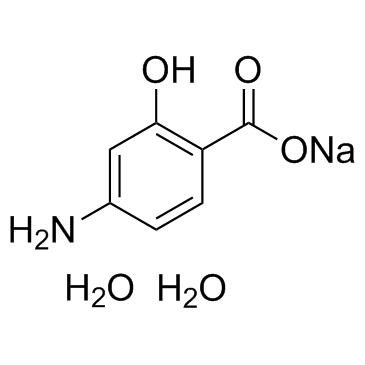Sodium 4-aminosalicylate dihydrate

Sodium 4-aminosalicylate dihydrate structure
|
Common Name | Sodium 4-aminosalicylate dihydrate | ||
|---|---|---|---|---|
| CAS Number | 6018-19-5 | Molecular Weight | 211.148 | |
| Density | N/A | Boiling Point | 380.8ºC at 760 mmHg | |
| Molecular Formula | C7H10NNaO5 | Melting Point | 250 °C | |
| MSDS | Chinese USA | Flash Point | 184.1ºC | |
| Symbol |

GHS07 |
Signal Word | Warning | |
|
Adsorption of phenolic compounds from aqueous solution using salicylic acid type adsorbent.
J. Hazard. Mater. 201-202 , 74-81, (2012) In this study, 5-aminosalicylic acid (5-ASA) was successfully grafted onto the poly(glycidyl methacrylate) (PGMA) macromolecular chains of PGMA/SiO(2) to obtain adsorbent ASA-PGMA/SiO(2). The adsorption properties of ASA-PGMA/SiO(2) for phenolic compounds wer... |
|
|
Comparison between 5-aminosalicylic acid (5-ASA) and para-aminosalicylic acid (4-PAS) as potential protectors against Mn-induced neurotoxicity.
Biol. Trace Elem. Res. 152(1) , 113-6, (2013) Manganese (Mn) is an essential metal for biological systems; however, occupational or clinical exposure to high levels of Mn can produce a neurological disorder called manganism. Oxidative stress and neuroinflammation play major roles in the Mn-induced neurod... |
|
|
Liver-selective expression of human arylamine N-acetyltransferase NAT2 in transgenic mice.
Drug Metab. Dispos. 39(5) , 882-90, (2011) Human arylamine N-acetyltransferase 2 (NAT2) mediates the biotransformation of arylamine drugs and procarcinogens into either innocuous or reactive DNA-damaging metabolites and is expressed predominantly in liver. Interspecies differences and incongruous resu... |
|
|
[Dynamics of proinflammatory cytokines during biologic therapy of inflammatory bowel disease].
Eksp. Klin. Gastroenterol. (3) , 47-58, (2012) Chronic inflammation in IBD is accompanied by an imbalance in the production of Tx1 and Tx2 cytokines. Imbalance of cytokine profile is important pathogenetic importance in chronic inflammatory process, since the formation of defective immune response to path... |
|
|
[Isolation of antibodies to Chlamydia and Mycoplasma pneumoniae during the immunosuppressive therapy of patients with inflammatory bowel disease].
Eksp. Klin. Gastroenterol. (3) , 40-6, (2012) Detection of IgM and IgG Chlamydia and Mycoplasma pneumoniae indicates an aggravation of intracellular infections, including, possibly, due to immunosuppressive therapy. It is possible that the intracellular infection may mediate the occurrence of certain ext... |
|
|
Macromolecular prodrug of 4-aminosalicylic acid for targeted delivery to inflamed colon.
Curr. Drug Discov. Technol. 10(1) , 16-24, (2013) Sterically hindered esters or esters of drugs with macromolecular carriers like dextran and cyclodextrin find wide applicability in colon-targeted delivery. We report here synthesis, in vitro release kinetics of macromolecular prodrug of 4-aminosalicylic acid... |
|
|
Multidrug-resistant tuberculosis that required 2 years for diagnosis.
BMJ Case Rep. 2012 , doi:10.1136/bcr.02.2010.2775, (2012) Isoniazid (H) or rifampicin (R) mono-resistant disease can be treated easily and effectively with first-line drugs, while combined H and R resistance (ie, multidrug-resistant tuberculosis (MDRTB)) requires treatment with at least four agents, including a quin... |
|
|
Drugs for inflammatory bowel disease.
Treat. Guidel. Med. Lett. 10(115) , 19-28, (2012)
|
|
|
Para-aminosalicylic acid plasma concentrations in children in comparison with adults after receiving a granular slow-release preparation.
J. Trop. Pediatr. 59(2) , 90-4, (2013) There are no paediatric data regarding slow-release para-aminosalicylic acid (PAS). We studied PAS plasma concentrations in 10 children receiving a single 150 mg/kg dose daily or 75 mg/kg twice daily and 12 adults receiving 4 g twice daily. Blood specimens pr... |
|
|
Novel pediatric delivery systems for second-line anti-tuberculosis medications: a case study.
Int. J. Tuberc. Lung Dis. 17(9) , 1239-41, (2013) Tens of thousands of children are sick with multidrug-resistant forms of tuberculosis (MDR-TB), but there are limited child-friendly delivery systems for second-line medications. This case study presents the development of a granular dosing spoon pediatric de... |